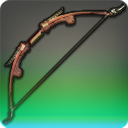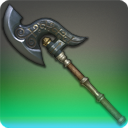From the archeological notebook of Archon Niniri Niri.
Weaponry:

The Antares Needles: A common pair of daggers in terms of design, equipped with cutting edges but primarily specialized for a stabbing point. These specific weapons seem to have been named for a previous inhabitant of the gaol, namely the dreadful banemite Antares, who was slain by adventurers within Toto-Rak before the calamity. These daggers may even have been named after their wielder died fighting Antares with them.
Etymology Notes: Antares is, of course, a star within the Scorpius constellation, which is why they are named for a diremite. Antares, as a boss of Toto-Rak in 1.0, accompanied Shaula and Graffias, both also named for stars in Scorpius, of which only Graffias yet lives.

The Bow of Owls: A shortbow, these weapons suit forest-dwellers well due to their slighter size, and are traditionally used by miqo’te tribes. This one seems to be decorated with the feathers of an owl, but little else differentiates it. It may well have been used by poachers imprisoned here.

The Crimson Tide: This is a form of polearm called a harpoon, a weapon first invented to act as tools for subduing the ocean’s more daunting inhabitants by hyuran fisherfolk on the Eorzean coastline, but when they migrated inland the spears proved just as useful for hunting the creatures of the forest. The name of this spear clearly implies its role as a nautical implement, as well as a somewhat gruesome fate for its enemies. This was likely a poacher’s weapon.

The Elmlord’s Tusk: A form of axe called a Bhuj, these weapons are foreign to Eorzea and were only introduced to Eorzea in the Sixth Astral Era by traders from Thavnair. They are notably popular amongst executioners for the advanced weight of the head. Who exactly the Elmlord was is unclear, but it being here suggests that they were not a particularly respected individual, and were instead a criminal of some form, or perhaps even a rival to Gridana’s hegemony.

The Frostbite: A blade of unique design, little can be discerned from the Frostbite. Perhaps it was a relic of the miqo’te, carried by their peoples over the ice bridges to Eorzea in the Fifth Umbral era, but any supposition is purely guesswork.

The Howling Talons: These are Baghnakhs, fist weapons invented by the Amalj’aa and popularized by Ul’dahn gladiators. Whoever employed these specimens was clearly a warrior with fast fists, judging by the name of the weapons, and may have been an Ul’dahn braggard who transgressed on the sacred laws of the Twelveswood.

The Kple Kple: A unique staff, the Kple Kple has a tale surrounding it of infamy and hubris. A conjurer who opposed the ruling class of Gridania crafted this staff by fusing two powerful reagents. The first was a mask apparently carved from the body of one of the tree-folk of Meracydia that worship Sephirot. How exactly this conjurer came by this is difficult to say, and it must have either been from trade with the southern continent itself or by trawling Allagan ruins. The second component was the living root of a heavenspillar, the prodigious and holy great trees of the Twelveswood. He believed that this staff would allow him to achieve communion with the elementals of the wood without the natural talent of the Hearers. Evidently it did not end well for him however, judging by his masterwork being found in Gridania’s foulest prison, which is likely where he ended up as well.
Etymology Notes: A kple kple is a sacred dance mask worn by a number of peoples of the Ivory Coast in real life, which may provide a hint towards the culture of Meracydia, or at least the race that worships Sephirot.

The Pupil’s Book of Brass: A common class of books, the pupil’s books are tomes bound in aetherically conductive metals that have been commonly promoted for their ability to quicken elemental energies, including by numerous instructors within the Studium.

The Taurus Staff: Staves such as these are useful tools for thaumaturges, both because their increased length allows for greater channeling of elemental energies, as well as their ability to be used as a crutch or even melee weapon if needed. This specific staff is named for the taurus, a form of voidsent that is often summoned by disreputable mages. This may imply that the bearer of this staff was imprisoned for forbidden summoning.

The Thalassian Targe: Targes such these are light shields of animal hide reinforced with little metal, prized for their ability to protect without weighing down their user. This particular targe’s name implies that it may have come from Limsa Lominsa, with thalassian of course meaning of the sea. Perhaps it was borne by a poacher heading inland from the coast.
Armor:
The Ascetic’s/Torturer’s Garb: A pieced-together set of clothing centered around a halfrobe, a form of garment favored by spellcasters that value unimpeded movement. An ascetic is, of course, an individual who lives a life of extreme austerity, typically as part of a religious devotion. This may be a reference to a conjurer either who helped to administer Toto-Rak, was imprisoned there, or wandered there and died after its closure. The monocle and duckbills found with the garb appear to be more definitively traced back to one of the prison’s torturers.
The Brigand’s Garb: A set of armor structured around an acton, a padded jacket initially worn under armor that has since developed into one worn independently by those seeking lighter protection. The name of this garb fairly clearly traces it back to a brigand imprisoned within the jail, and the eye-mask being named nighthawk may imply that was the brigand’s title, or that it belonged to a second inmate with that name.
The Warden’s Garb: A relatively simple set of light armor, this was evidently the garb worn by the warden of the gaol, although the chestpiece was apparently stamped with the name ‘The Eternal Shade’. What exactly this could mean is unclear, though it may have been a statement of the power of the warden, or even have belonged to a criminal who went by that name.




Leave a Reply